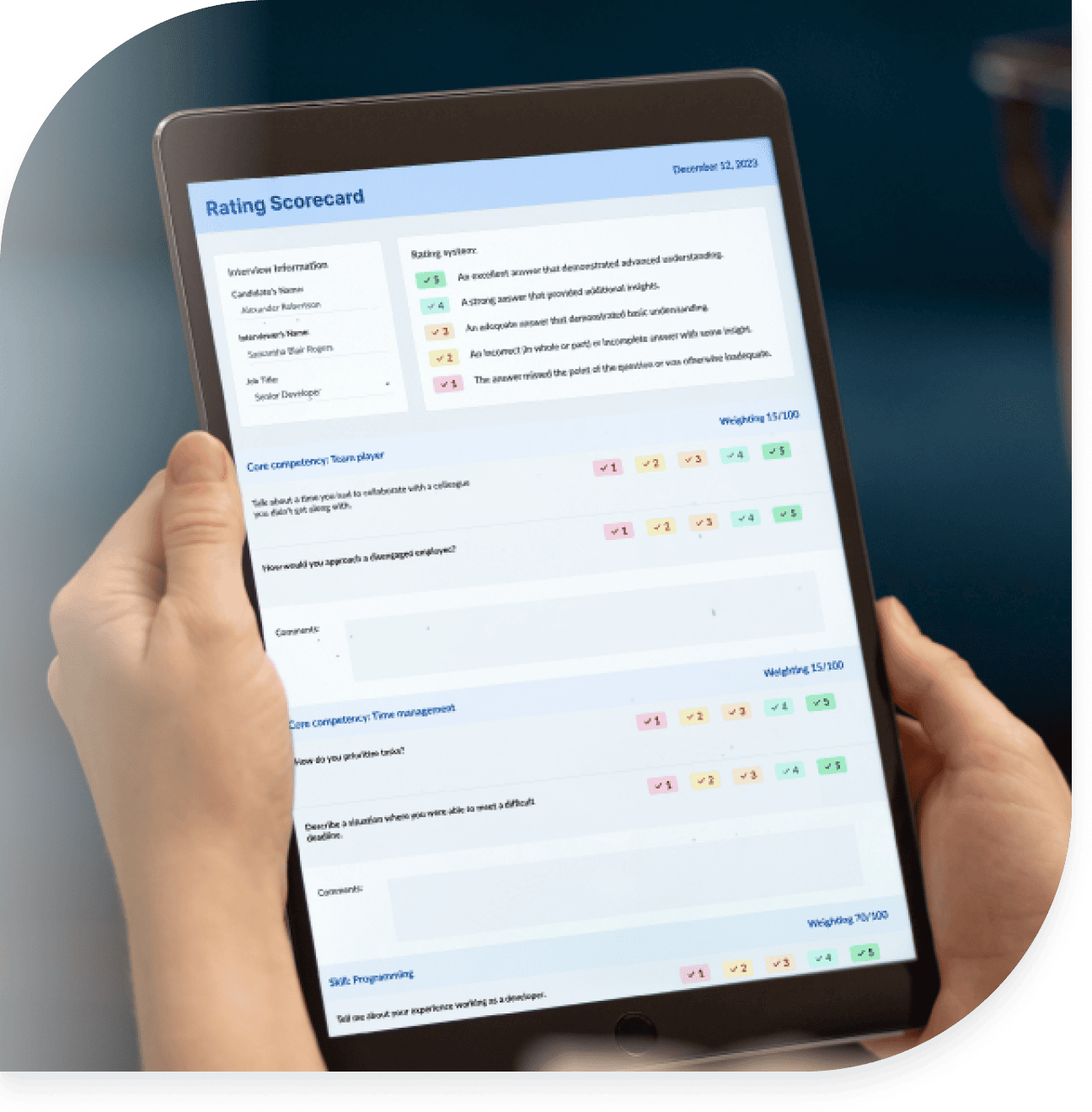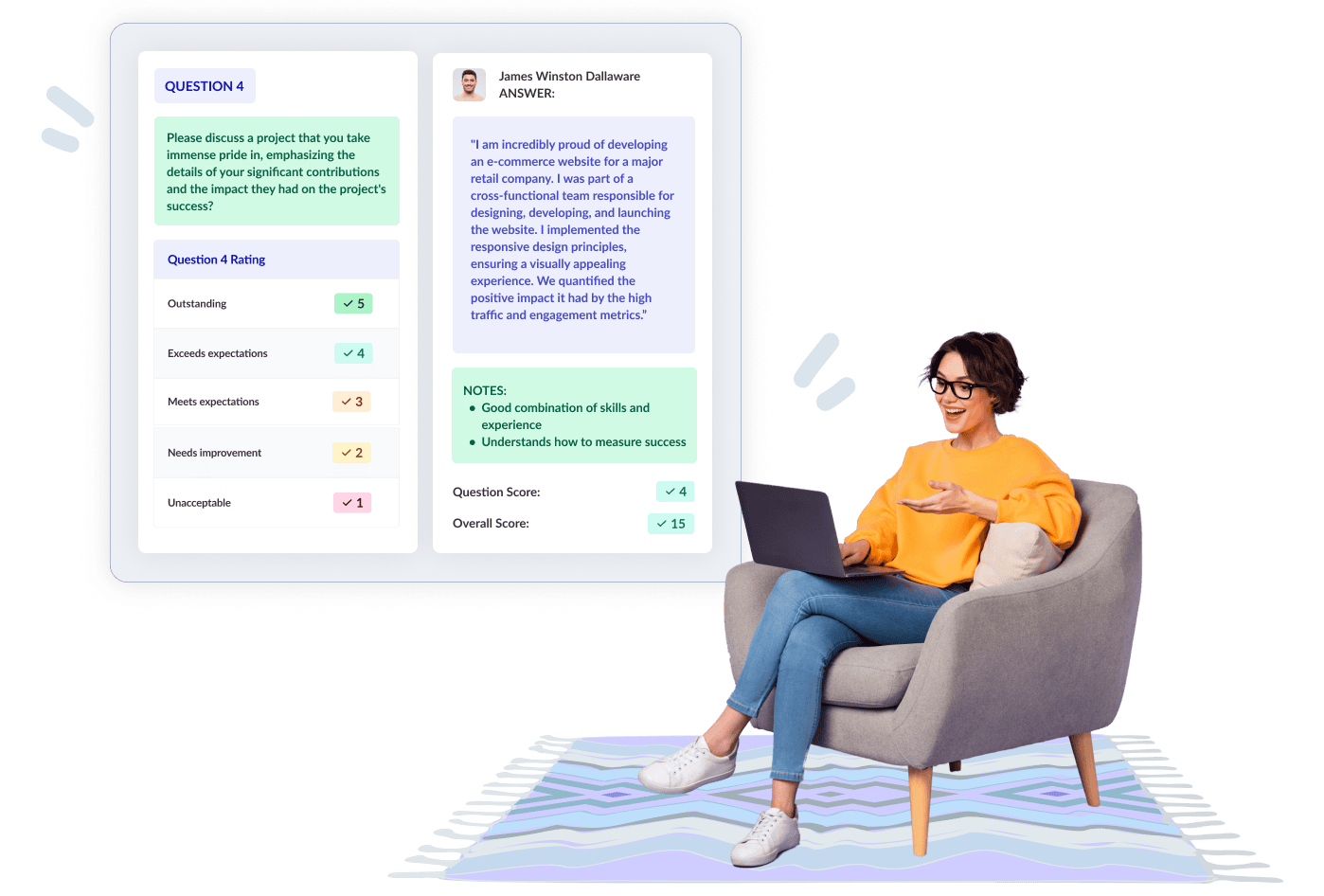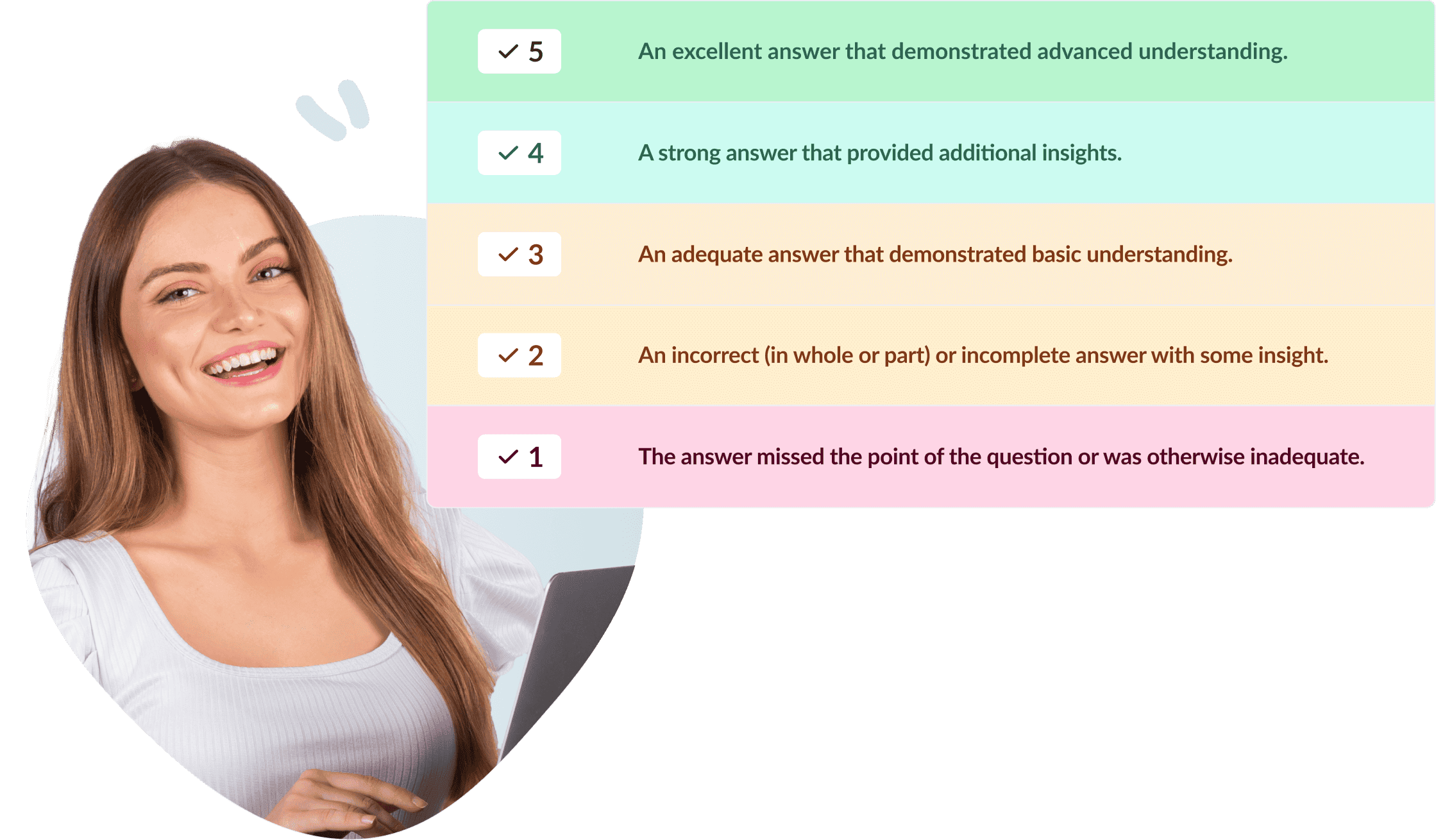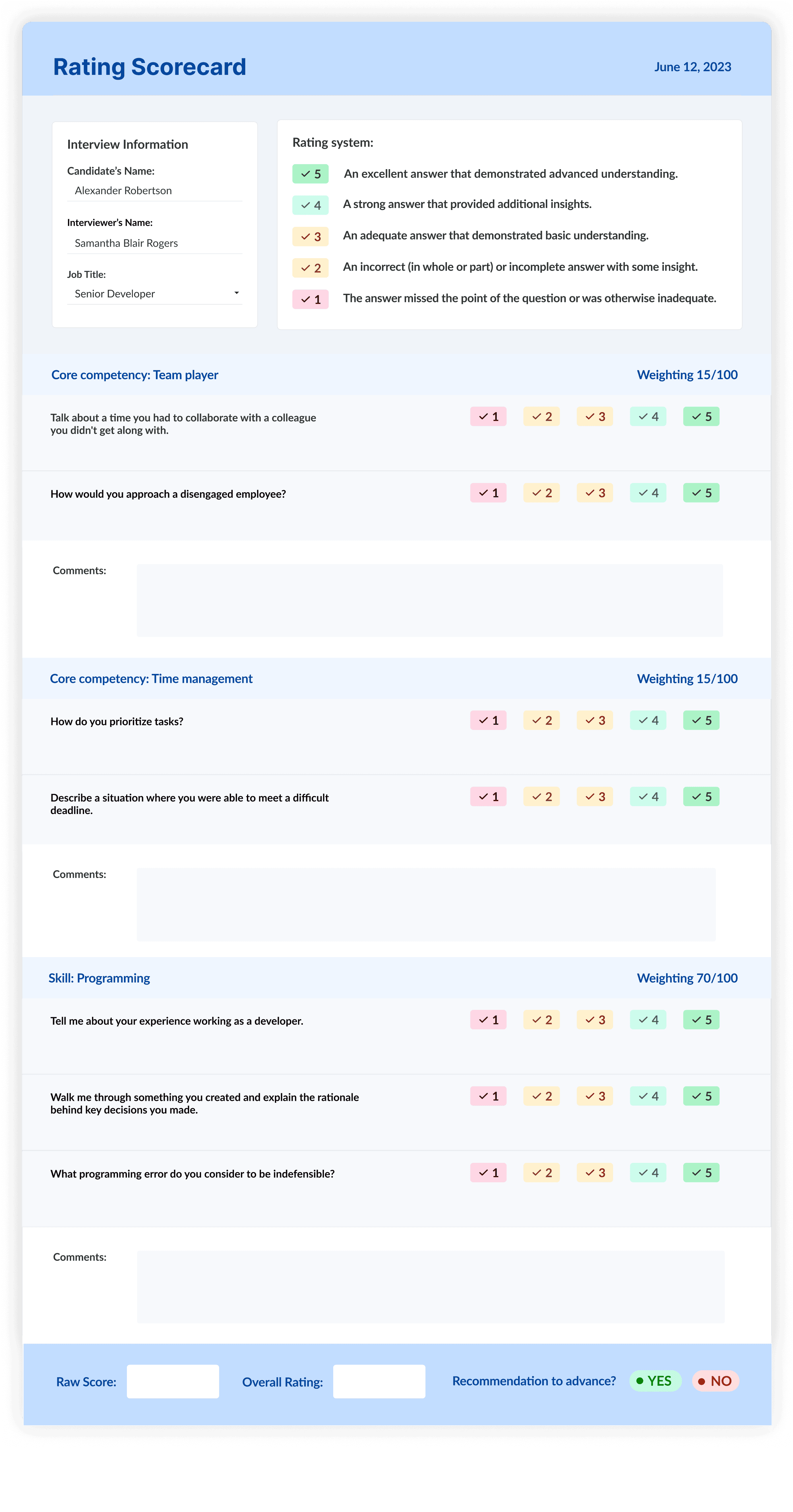
What is an Applicant Tracking System?
Applicant tracking systems are crucial components to recruitment automation. Learn how in our guide.

TL;DR: What Is an Interview Scorecard?
Interview scorecards are a valuable tool that HR teams, hiring managers, and other interviewers can use to rate and rank candidates objectively.
Consider this. Most employers interview 6-10 applicants for each position, with many going through 2-3 rounds of interviews, according to CareerSidekick. Multiply those numbers by the dozens, or even hundreds, of openings a company has at any point in time, and it’s easy to see why it feels so hard to pick the best person for the role.
Interview scorecards make interview evaluations easier (and fairer). This article examines the significance of interview scorecards and offers guidance on creating and using them effectively.
An interview scorecard is an assessment tool, often used as a part of a structured interview process, to standardize applicant evaluations. Interview scorecards enable interviewers to evaluate all candidates against the same predetermined criteria and competencies, identifying whether they possess the necessary skills for a role.
Also known as a candidate scorecard, interview scoring sheet, rating guide, interview rubric, or recruitment scorecard, an interview scorecard is part of an interview guide, which contains the information an interviewer needs to conduct a structured interview for a specific position.
Once all candidates have been interviewed and rated, the hiring manager typically reviews the results, discusses the scores with other panelists (if it was a panel interview), and decides who moves forward.

Learn how to set up a structured interview process
While closely related and sometimes used interchangeably, evaluation forms, interview scorecards, and interview rubrics are distinct concepts.
Evaluation forms are general tools for collecting feedback from interviewers. Their structure can vary widely and may or may not include open text, checkboxes, rating sections, and a formal scoring method. They’re used to gather overall feedback and impressions after an interview.
Interview scorecards are a type of evaluation form explicitly designed for structured interviews. They’re used to rate responses to interview questions tied to core competencies and typically include competencies, rating scales, notes, and recommendations.
Interview rubrics are highly structured and descriptive scoring guides that provide a clear framework for evaluating candidates. Often a component of a well-designed interview scorecard, rubrics provide detailed, precise definitions of what constitutes “good” or “poor” responses, as well as what a score of “3” versus “5” looks like.
In short, all interview rubrics and interview scorecards are evaluation forms, but not all evaluation forms are structured or detailed like scorecards or rubrics. Interview rubrics define the “why” and “how” behind candidate ratings, while the interview scorecard is the form where ratings are recorded.
When used as part of a structured interview process, candidate scorecards can benefit your organization in several ways.
Recruitment scorecards remove subjectivity. They assess everyone against the same criteria while accounting for accommodations, making the process fairer.
Interview scorecard sheets can also improve interview compliance by making it easier for interviewers of all levels to follow best practices and harder to stray from the process (thanks to settings in the platform).
What is interview compliance?
Interview compliance is a framework that ensures all interviews adhere to proven methods and procedures, maximize effectiveness and fairness, and remain responsive to legal, ethical, and social values.
Interview scorecards serve as formal documentation that can make your decisions more legally defensible. Rating data can demonstrate why certain hiring decisions were made and prove they weren’t discriminatory.
When used correctly, interview scorecards can also prevent adverse impact or discrimination claims from happening because they are a fair way to evaluate candidates.
A well-designed recruitment scorecard provides interviewers with a significantly better chance of selecting a high-quality candidate. Why? Interview scorecards are part of a structured interview process. McGill University found that structured interviews improve accuracy, making them a reliable method for predicting future job performance.
Another thing to consider is that everything on an interview scorecard sheet is directly related to the role you are hiring for. By only measuring the things that matter, you can collect better data and make better hiring decisions.
Creating an interview scorecard template helps everyone align on what an ‘ideal’ applicant would bring to the role.
For panel interviewing, standardizing the rating process makes it easy to compare scores. Diverse opinions and scores then open up the discussion about who should move forward and why.

When combined with interview questions that predict future performance, a recruitment scorecard can help you figure out who is right for a role much faster.
First, isolate the most effective questions and put them earlier in the process. From there, weight the ratings associated with these questions heavier on the interview scorecard. This weighted approach to scoring is especially helpful when candidates are very close because you can compare their performance on these specific questions to expedite the process.
With recruiting scorecards, there is also a cadence that is established through repetition. Interviewers become more efficient at rating as they use scorecards, and hiring managers learn how to utilize scores to make informed decisions efficiently.
Standardization is a very effective way to reduce bias. Interview scorecard templates allow employers to offer a repeatable and objective evaluation experience.
Preventing hiring bias using interview intelligence
Consider leveraging AI to identify interviewer scoring habits that may be a result of unconscious bias. Interview intelligence can help by pointing out rating tendencies, coaching interviewers to course correct, and setting your structured interview process up for continuous improvement.

When you use recruitment scorecards, each step of the interview process is assigned a score. This approach allows hiring managers to compare each step of the candidate’s journey to confirm they’ve performed well throughout the process based on data, not on hindsight.
In a structured interview process, interview scorecards are companions to interview guides. Interview guides provide the roadmap to ensure every interview conducted for a particular position is consistent and focused. At the same time, interview scorecards offer the vehicle to capture interviewer feedback about candidates consistently.
Both should be rooted in a job analysis, which outlines details about the position, what competencies are needed, and other requirements for the role.
Well-designed interview scorecards will mirror the job analysis findings and:
*These are often competencies directly related to organizational objectives or values.
Interview scorecard templates can empower hiring managers across the organization to adopt sound, repeatable hiring practices. Every role-specific scorecard template becomes a roadmap for the future when you’re rehiring for that same job.
When created correctly, recruiting scorecards don’t exist on their own — they are an essential part of a structured interview process. If your organization isn’t already using structured interviewing, this is your sign to explore it and gain leadership buy-in for this approach to recruiting and hiring.
Every position has unique requirements for success in the role. A job analysis, which the U.S. Office of Personnel Management describes as “the foundation for all assessment and selection decisions,” will guide the creation of interview guides and their companion candidate scorecards.
While every position should have its own interview guide, there’s a lot of overlap across roles. Universal or repeated sections might include organizational policies, interview types and formats, and pre- or post-interview logistics, as well as accessibility issues.
Unique interview guide sections typically focus on the job description and requirements for the role, which are used to design specific questions to assess fit.
While the specifics will vary, interview scorecards should contain placeholders for the following information:
Whether you use generic scales or develop very specific rubrics by question, every scorecard should provide interviewers a consistent way to rate candidate responses.
There are three common types of scales:
Likert scale
Likert scales measure opinions, perceptions, and behaviors. Each number provides a detailed description of the associated competency level.
Behaviorally Anchored Rating Scale (BARS)
BARS requires the interviewer to compare the candidate’s answers about past or future behavior against behaviors sorted according to levels of competency (usually ranging from 1 to 5, with 1 representing the least ideal behavior). The descriptions in this scale are based on real experiences.
Behavioral Observation Scale (BOS)
Similar to BARS, BOS is a behavior-based measure used in relation to situational questions to evaluate performance.

Determine how you will aggregate the evaluation data. Will you manually tally everything in a spreadsheet, or are you using a digital rating guide that automatically compiles and saves everything? If it was a panel interview, leave time for a collaborative discussion about who to advance.
Next, decide if you’ll advance all candidates who achieve a certain score or the top 3-6 candidates. Determine these parameters in advance and alter them as needed once hiring is complete.
Simply creating an interview scorecard isn’t enough. How it’s used impacts how effective it will be. Here are some key considerations to ensure a candidate scorecard is used effectively.
The most accurate way to complete an interview scorecard is during the interview itself. Rating as you go, before moving on to the next question, can decrease opportunities for hiring bias.
“[Rating as you go] neutralizes a variety of biases: We are more likely to remember answers with vivid examples, for example, and answers that are most recent. Evaluators who wait until the end of the interview to rate answers risk forgetting an early or less-vivid but high-quality answer, or favoring candidates whose speaking style favors storytelling.”
Iris Bohnet
Train Interviewers on Note-Taking and Using the Scorecard
Train interviewers to avoid capturing inferences or judgments in their interview notes. When writing notes, interviewers should focus on what the candidate is describing, when it took place, what they did, or would do, and the results. Focus only on what they are saying, and avoid letting other details sway your rating.
Explain The Scorecards to Candidates
Put candidates at ease and improve their experience by explaining what you’re looking for and how you’ll be assessing them at the beginning of the interview. Don’t forget to ask if they have any questions.
Create an Interview Scorecard Template
Once you’ve created and tested a scorecard for a position, make it into a scorecard template. An interview scorecard template can save a lot of time, especially if you hire for that role frequently. Create templates for all roles so the entire organization can realize the benefits of candidate scorecards.

A resume score is based on the contents of a candidate’s resume, not interview answers and performance. Many Applicant Tracking Systems use AI to check and organize resumes. Depending on the platform, humans select candidates to interview from a suggested shortlist, or AI advances candidates.
Scoring resumes this way can speed up the process, but it’s considered high risk to leave decision-making entirely in the hands of AI. The decisions could be based on biased data, and it can be hard to understand the algorithm’s choices. Employers are equally as responsible as AI vendors if discrimination occurs, which is why giving AI this responsibility is high risk.
If you want to put interviewing best practices into place in your process, the short answer is yes. To be compliant, a candidate’s answers must be scored using a standardized rating guide and submission process.
If it’s a panel interview, questions should be rated independently during the interview to prevent the introduction of bias.
An interview scorecard should include job-related competencies, rating scales or rubrics, a section for notes, an overall score, and a recommendation on next steps. All elements should align with a structured interview guide and job analysis to ensure fairness and consistency across candidates.
The best scoring methods include Likert scales, BARS (Behaviorally Anchored Rating Scales), and BOS (Behavioral Observation Scales). Each offers structured, repeatable ways to evaluate responses and reduce subjectivity in your candidate scorecard.
Yes. Interview scorecards standardize the evaluation process, helping to reduce unconscious bias. By rating each response in real-time using a structured guide, you create a fairer and more objective interview process, helping to prevent discrimination claims.
Absolutely. Using the same interview scorecard template across interviewers ensures consistency in evaluation and supports structured, equitable hiring decisions. It also makes comparing candidates across interview panels much easier.
A rubric provides detailed descriptions of scoring criteria (e.g., what a “3” vs. “5” looks like). A scorecard is the form where those scores are recorded. Rubrics are often built into interview scorecards to guide consistent ratings.

E-BOOK
The Modern Guide to Structured Interviewing
Get your free copy of VidCruiter’s comprehensive white paper about structured interviewing. This practical guide:
By providing email address, you agree to receive
updates from VidCruiter.
Read our
Privacy Policy
Modernize your hiring process with expert insights and advice.